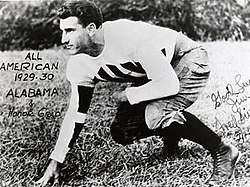Fred Sington
Frederic William Sington (February 24, 1910 – August 20, 1998) was an American football and baseball player. Sington was also an accomplished saxophonist.[1] Sington was born in Birmingham, Alabama, and was Jewish.[2] He attended Phillips High School.[3][4]
 | |
| Alabama Crimson Tide – No. 43 | |
|---|---|
| Position | Tackle |
| Class | Graduate |
| Career history | |
| College |
|
| Bowl games | |
| High school | Phillips |
| Personal information | |
| Born: | February 24, 1910 Birmingham, Alabama |
| Died: | August 20, 1998 (aged 88) Birmingham, Alabama |
| Height | 6 ft 2 in (1.88 m) |
| Weight | 215 lb (98 kg) |
| Career highlights and awards | |
| |
| College Football Hall of Fame (1955) | |
| Fred Sington | |||
|---|---|---|---|
| Outfielder | |||
| Born: February 24, 1910 Birmingham, Alabama | |||
| Died: August 20, 1998 (aged 88) Birmingham, Alabama | |||
| |||
| MLB debut | |||
| September 23, 1934, for the Washington Senators | |||
| Last MLB appearance | |||
| June 16, 1939, for the Brooklyn Dodgers | |||
| MLB statistics | |||
| Batting average | .271 | ||
| Home runs | 7 | ||
| Runs batted in | 85 | ||
| Teams | |||
| |||
College football
Sington was a prominent two-time All America tackle for Wallace Wade's Alabama Crimson Tide football teams.[4] While in college he was a member of the Zeta Beta Tau fraternity, Psi chapter at the University of Alabama. He was elected to the College Football Hall of Fame in 1955. Sington was chosen for an Associated Press Southeast Area All-Time football team 1920–1969 era.[5]
1930
In 1930, a year in which Alabama won the national championship and Sington was an All-American,[6] Rudy Vallée wrote a song about Sington, entitled "Football Freddie", that would go on to become a nationwide hit.[7]
Baseball
In 1932 he led the Middle Atlantic League with a batting average of .368 and a slugging percentage of .720, and in triples with 12 and home runs with 29.[8] In 1936 he was third in the Southern Association with a batting average of .384 and a slugging percentage of .589, as he led the league with 22 triples.[9]
He would also play professional baseball as an outfielder with the Brooklyn Dodgers and Washington Senators, batting .271/.382/.401.[10]
Death and burial
He is buried in Birmingham's Elmwood Cemetery.
References
- "Did You Know That". Freeport Journal-Standard. December 5, 1929. p. 16. Retrieved March 13, 2015 – via Newspapers.com.

- "Big League Jews". Jewish Sports Review. 12 (137): 21. January–February 2020.
- Peter S. Horvitz, Joachim Horvitz. The Big Book of Jewish Baseball. Retrieved February 6, 2020.
- Ron Ingram, Rubin E. Grant. Tales from Alabama Prep Football. Retrieved February 6, 2020.
- "All-Time Football Team Lists Greats of Past, Present". Gadsden Times. July 27, 1969.
- Alan Gould (December 6, 1930). "MIDDLE WEST HOLDS EDGE IN SELECTION OF 1930 ALL-AMERICAN GRID TEAMS: POLL BY ASSOCIATED PRESS SELECTS STARS FOR MYTHICAL ELEVEN". Evening Independent.
- Groom, 2000, p. 57.
- "1932 Middle Atlantic League Batting Leaders". Baseball-Reference.com. January 1, 1970. Retrieved February 6, 2020.
- "1936 Southern Association Batting Leaders". Baseball-Reference.com. January 1, 1970. Retrieved February 6, 2020.
- "Fred Sington Stats". Baseball-Reference.com. Retrieved February 6, 2020.
- Groom, Winston. The Crimson Tide – An Illustrated History. Tuscaloosa: The University of Alabama Press, 2000. ISBN 0-8173-1051-7.
External links
- Career statistics and player information from Baseball-Reference, or Fangraphs, or Baseball-Reference (Minors)
- Fred Sington at Find a Grave
- Fred Sington at the College Football Hall of Fame